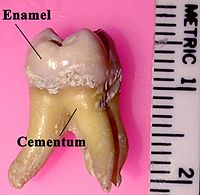
Photo from wikipedia
OBJECTIVES To evaluate the association and level of evidence between socioeconomic status (SES) and tooth wear (TW) in children, adolescents, and adults. DATA Eligibility criteria comprised population-based observational studies assessing… Click to show full abstract
OBJECTIVES To evaluate the association and level of evidence between socioeconomic status (SES) and tooth wear (TW) in children, adolescents, and adults. DATA Eligibility criteria comprised population-based observational studies assessing the association between SES and TW in permanent dentition of adolescents and adults. Interventional and descriptive studies or those without an internal comparison between exposed and nonexposed groups were excluded. The Preferred Reporting Items for Systematic Reviews and Meta-Analyses (PRISMA) guidelines were applied where applicable. Risk of bias (RoB) was assessed using the Newcastle-Ottawa scale. Meta-analyses were conducted to estimate the pooled effect measures. Q-statistic, I2 statistic, and subgroup and sensitivity analyses assessed study heterogeneity. SOURCES PubMed/Medline, Embase, Scopus, Web of Science, LILACS, SciELO, Cochrane Library, and Google Scholar databases were searched for articles published in English between 1st January 1980 and 31st March 2021. RESULTS Sixty-five studies were included, involving 63893 participants in over 30 countries. A positive association was found between TW and education (OR=1.25 [0.96; 1.62]), family income (OR=1.18 [0.91; 1.53]), and private school (OR= 1.24 [0.90; 1.72]) among adolescents. Higher educated adults had a lower risk for TW (OR=0.70 [0.52; 0.93]). Most included studies had a moderate RoB. Limitations relating to population representation and assessment methodologies were identified in the included studies. CONCLUSIONS SES was associated with TW with its direction depending on the individuals' age. The overall quality of evidence was moderate. CLINICAL SIGNIFICANCE SES should be included as part of the routine screening and risk assessment for tooth wear.
Journal Title: Journal of dentistry
Year Published: 2021
Link to full text (if available)
Share on Social Media: Sign Up to like & get
recommendations!